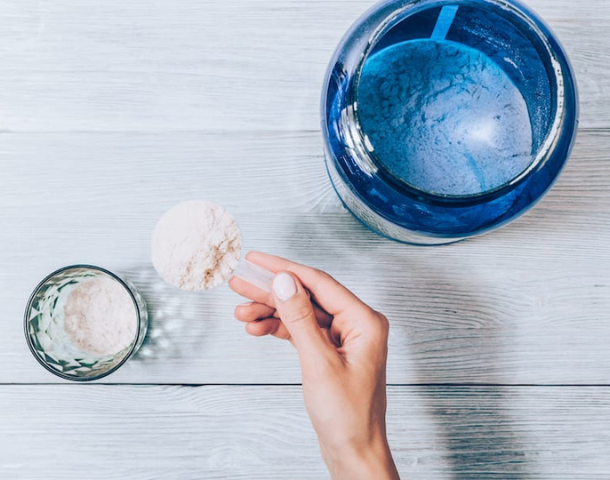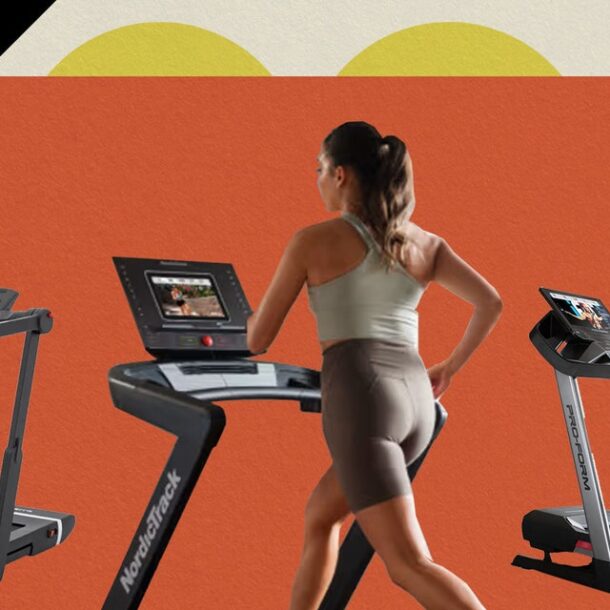
How to Safely Exercise When You Have POTS
Physical therapist and strength coach Susie Spirlock, DPT, played sports and exercised her whole life. “I placed a large part of my identity in what I could do in the gym,” she tells SELF.
But after she got COVID in 2020, symptoms like fatigue, brain fog, and shortness of breath lingered. A year after getting sick, her heart rate would spike into the 130s when she was simply sitting on the couch. And when she tried to work out, she felt dizzy, faint, and nauseous.
After Dr. Spirlock went to a cardiologist and neurologist, she was diagnosed with long COVID, dysautonomia, and postural orthostatic tachycardia syndrome (more commonly known as POTS). Dysautonomia is a disorder that affects your autonomic nervous system—which controls body functions you don’t have to think about, like your blood pressure and heart rate—and POTS is a specific type that causes symptoms when you go from lying or sitting to standing.
At first, Dr. Spirlock was afraid she’d never be able to exercise again. But over the course of four years, she discovered that physical activity actually played a key role in helping her feel better, provided she adapted her routine accordingly. Here’s some of what she, and other experts, have learned about the complex back-and-forth between exercise and POTS.
POTS can make exercise tricky, but that doesn’t mean you should skip it.
POTS messes with the normal physiological process that occurs when you stand up: Gravity tries to pull your blood downward, away from your brain, Blair Grubb, MD, a cardiologist and POTS specialist with the University of Toledo College of Medicine and Life Sciences, tells SELF. Your body responds by increasing levels of norepinephrine, a neurotransmitter that increases your heart rate, and your brain sends signals to the blood vessels in your legs to constrict to push the blood back up, Dr. Grubb says.
With POTS, the nerves in your lower body don’t respond properly. Your heart keeps beating faster and faster, even as blood pools in your legs and feet. The less blood that reaches your brain, the more severe your symptoms. People with mild POTS might feel a bit tired, then like they can’t focus or concentrate. It can escalate to include dizziness, lightheadedness, seeing black spots or tunnel vision, and possibly passing out.
Because exercise often involves changes in position or being on your feet for long periods, it can exacerbate symptoms, Dr. Spirlock says. In fact, an inability to tolerate exercise is one of the hallmark signs of POTS. And it often goes hand in hand with a condition called post-exertional malaise, which can cause symptoms like heart palpitations, headaches, and chest pressure anywhere from 12 hours to several days after exercise, Naomi Bauer, DPT, a physical therapist and coach who specializes in POTS, tells SELF.
While physical activity can trigger symptoms, it’s actually a proven treatment for POTS as well, Benjamin Levine, MD, a professor of medicine and cardiology and founding director of the Institute for Exercise and Environmental Medicine at UT Southwestern Medical Center, tells SELF. Aerobic exercise boosts circulation at the moment and leads your body to create more blood over time, stabilizing blood pressure. Your heart and muscles will also grow stronger, which is why strength training is also beneficial.
Exercise also strengthens bones (especially important since POTS can increase your risk of falling) and reduces the risk of blood clots. The feel-good brain chemicals your workout produces may also help relieve pain from conditions that often accompany POTS, such as hypermobility and fibromyalgia. And if you’re like Dr. Spirlock, getting back to exercise can simply help you feel more like yourself. The road isn’t always easy, she says, but these tips can help.
1. Track absolutely everything.
This is the first thing Dr. Bauer recommends when she starts working with a new patient with POTS. You can use pen and paper, a spreadsheet, a general app like Guava Health, or a sport-specific one like TrainHeroic (for strength training) or TrainingPeaks or Strava (for cardio), which helps you track the amount of weight you’re lifting, reps you’re doing, mileage you’re logging, and pace you’re hitting. Note how you feel before and after exercise and following the everyday stuff like taking a shower or doing laundry or cooking..
“It allows you to start to see patterns and correlations,” Dr. Bauer says. “People may not realize that what they did yesterday is impacting how they feel today.” If you feel more limited after exertion, or if exercise drags you down instead of giving you an energy boost, those are signs you might have post-exertional malaise and should proceed extra cautiously with your workouts, Dr. Bauer says.
Tracking can help you fine-tune your activities to reduce symptoms, plus offer you a bigger-picture perspective on days you’re not feeling great. “When you have flare-ups or times when you have to regress a little bit, you can go back and see, ‘Last month, I was doing way less than I am now,’” Dr. Spirlock says.
2. Start where you are, and build up (slowly) from there.
As Dr. Spirlock learned, you might not be able to jump right back into your regular training after a POTS diagnosis. “We have a goal for our patients to be doing 20 to 30 minutes of aerobic activity three times a week,” Dr. Grubb says. “But I tell them, you may have to start with five minutes, you may have to start with one minute. Start somewhere and you begin to add to that.”
If you’ve been sidelined for a while or have post-exertional malaise, that might mean beginning with breathing exercises or laying on your back and doing heel slides, a gentle movement that involves straightening, then bending, each leg, Dr. Bauer says.
Some programs have been created to help people with POTS progress in their exercise routines—including the Levine Protocol (developed by Dr. Levine) and another one adapted by the Children’s Hospital of Philadelphia—but not everyone can stick to the exact timelines they establish, Dr. Grubb says. Rather than get yourself down over not being able to hit a set target, remember that any amount of movement is beneficial, and with time and patience, most people will be able to eventually do more, he says.
3. Try seated or recumbent exercises.
Because POTS symptoms are worse when changing positions, you might feel better when your body is horizontal—and the good news is, there are tons of ways to exercise like that. Consider a recumbent bike, rower, or seated elliptical like a NuStep. Swimming is also great if you have access to it, Dr. Grubb says: “When you’re in the water, it’s like having a giant compression suit around you.”
As you build strength and fitness, you can try upright cycling, treadmill walking, elliptical, and then running. An AlterG antigravity treadmill can also help you get back into running, Dr. Levine says; check their website at alterg.com to find one near you.
A similar progression works for strength training. Dr. Spirlock began with seated or close-to-the-ground exercises as an “entry point:” hip thrusts and leg presses instead of squats and deadlifts, and upper-body movements like rows and overhead presses on a bench. “As your body adapts—because the body is widely adaptable—you can start incorporating other things,” she says. For example, she went from a leg press to a box squat with a high box, which involved less range of motion than a full squat and also offered her a place to sit if she felt dizzy. “As symptoms started to decrease, then I would lower that box,” she says. “Now I’m back to full-depth squats.”
Also, some people find strength training causes fewer symptoms than cardio (or vice versa). While you’d ideally work up to doing both, it’s okay to start with what’s most comfortable for you—doing anything may eventually make it easier to do everything, Dr. Grubb says.
4. Stay hydrated and supplement with sodium.
Drinking lots of water boosts your blood pressure and blood volume, and salt helps your body retain fluids as well as offsets the extra norepinephrine that’s jacking up your heart rate. In fact, people with POTS might need between 3,000 and 10,000 milligrams of the mineral daily, which is way more than the typical government-recommended 2,300-milligram guideline for the general population.
Dr. Spirlock has found her sweet spot at two to four liters of water and 6,000 milligrams of sodium per day, which she hits by salting her food and using LMNT electrolyte drink packets. She also recommends a boost of 500 milligrams about an hour before you work out to ensure you’re prepared. (Just avoid salt tablets, Dr. Levine says—they’re so concentrated that they can be dehydrating.)
5. Don’t forget the warm-up and cooldown.
A good warm-up helps everyone, but it’s critical for folks with POTS, Dr. Spirlock says. Before strength training, she spends five to 10 minutes on dynamic movements like dead bugs and thread the needle that increase her heart rate and circulation and fire up the connections between her mind and muscles. If you’re doing cardio, ease in with five to 10 minutes of lower-intensity work—think easy biking.
Cooling down afterward can help your body relax into a more parasympathetic state. One of Dr. Spirlock’s favorite post-lift routines is lying on the floor, elevating her feet and legs on a bench, and doing some 360-degree diaphragmatic breathing: inhaling deep into your chest, so your ribcage expands in all directions.
6. Consider the conditions.
Most people with POTS feel worse in the heat. Working out indoors in air conditioning can help, or you can modify your routine to adjust to the conditions, Dr. Spirlock says. For example, she often reduces her intensity or shortens her session if she’s lifting in her hot garage gym in the summer. You can also try cooling towels or spritzing yourself with cold water.
7. Add in more rest breaks—and make them longer too.
Dr. Bauer encourages people with POTS to use pacing, a method that can help you learn to manage your energy and prevent you from overexerting yourself and then crashing. What this looks like is highly individual, but it may involve taking a rest break—whether that’s five minutes of deep breathing or 30 minutes of yoga nidra—before and/or after you exercise. Experiment with different types and durations of rest and exertion, tracking to see how they affect you, she says.
You may also need longer rest breaks between sets during strength training, especially for large compound movements like squats, deadlifts, and lunges. By the end of a set of squats, Dr. Spirlock will typically feel lightheaded as her heart rate spikes and her blood pressure tanks. So she crouches down closer to the ground, waits to feel better, then slowly works her way back up to standing, as she demonstrates in this Instagram post.
She waits until her heart rate comes down and other symptoms subside for 30 to 60 seconds before starting the next set. When she first began training again, she needed five to six minutes of rest between sets of heavy compound exercises like squats; now, she’s down to two or three minutes (similar to what she took before she got sick), even though she’s lifting heavier. “That’s another big way you can track progress over the long term,” she says.
8. Try monitoring how you feel instead of only going by your heart rate.
When you’re first getting back into exercise, wearing a heart rate monitor can help you keep tabs on your intensity; your doctor may give you specific targets for your routine. Keep in mind, this will likely change as your body acclimates to exercise again.
For example, Dr. Spirlock found that as she got fitter, heart rate data alone became less useful and even led to a plateau. Her heart rate would climb into the 130s and 140s even when she was walking, so she’d never push herself past that. So she switched to using the “talk test” to gauge her intensity. This means for cardio, she now pushes hard enough that she can still have a conversation, even if it’s brief or strained. Instead of monitoring her heart rate, she runs until she starts breathing so heavily she can’t speak, then takes a walk break until she recovers. Using that method, she’s gradually increased her running time, enough so that she’s now targeting a half marathon. (Talk with your doctor about what’s right for you, of course.)
For strength sessions, she monitors intensity using reps in reserve (RIR). “An RIR of two means that I did that exercise and I think I maybe could have done two more reps,” she says. An RIR of two or three is generally best for building and strengthening muscle, but on days she’s not feeling as well, she’ll aim for an RIR of four or five instead. “I’m not pushing my body quite as hard, but I’m still getting all those benefits of exercise,” she says.
9. Have a plan…but adapt as needed.
This attitude is a huge part of exercising with POTS and other chronic conditions, Dr. Spirlock says. Don’t be afraid to dial back the intensity, return to recumbent exercises, add more rest, or cut a session short if your symptoms are flaring up.
“I challenge everyone with POTS to approach their exercise that way—go in with a plan but be okay with that plan not going according to plan,” she says. “That way, you’re not beating yourself up at the end of the workout if you can’t quite finish. The fact that you got out there in the first place and got some movement in is going to pay off in the long run.”
In fact, if you have post-exertional malaise, ignoring symptoms can backfire, Dr. Bauer says. “Stop and listen to what your body’s saying, because pushing through will make you feel worse,” she says.
10. Get help if you need it—but make sure it’s from the right places.
Many people with POTS struggle to find medical providers who take them seriously and understand how to treat them. If you have a medical team you trust, talk with them about your exercise program. Discuss what symptoms you might expect and report anything new or unusual. For instance, while it’s normal for people with POTS to have some symptoms when exercising, the worsening of something like chest pain warrants further evaluation, Dr. Levine says.
A physical therapist or certified personal trainer can help guide you, and ideally they’d have experience working with folks who have POTS. Even if you don’t have the resources to hire them, finding and following experts who treat or have POTS on social media can provide inspiration and community. “People aren’t alone,” Dr. Spirlock says.
Four years later, she’s back to the same level of strength training as before getting sick. Her POTS symptoms have improved even when she’s not working out—for example, she doesn’t always get dizzy when she stands up from the couch.
“I’m not going to sit here and say the journey for me getting back to strength training with POTS was glorious, because it wasn’t. It was frustrating. It was foreign to me; there were lots of tears,” she says. “But then there’s also lots of happiness that came out of that because I did stick with something, knowing that these adaptations take a long time to happen.”
Related:
Related Articles
2023 Healmyselfnow @ All Rights Reserved


